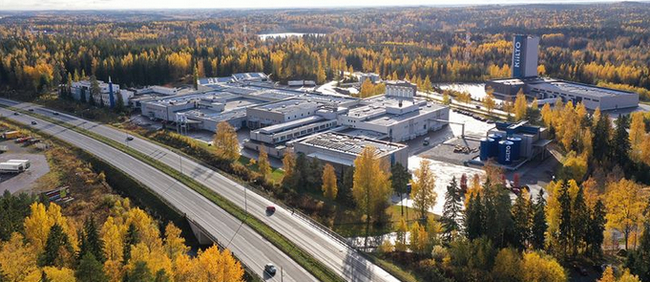As a result of an energy ecosystem by Kiilto and the heating company Lempäälän Lämpö, the district heating network in the Sääksjärvi area makes use of carbon-neutral district heating during the summer months. Kiilto benefits by getting closer to its carbon balance targets.
Plenty of waste heat is created in industrial processes at the Kiilto plant, which has already been utilised in the heating of Kiilto’s own premises. However, during the warm season, there is more heat than needed. Thanks to a partnership that began in September 2022, this waste heat is being utilised in the Lempäälä district heating network.
District heating produced with waste heat increases during the summer, and so far 1,100 MWh of energy has been produced into the district heating network. This has resulted in a decrease in natural gas consumption of approximately 1,000 MWh in the Sääksjärvi area.
“The Sääksjärvi customers consist of households, housing companies and industry. According to calculations by Finnish Energy, one detached house uses about 18 MWh of energy per year, meaning that the benefits created by the energy ecosystem are significant. People do not heat their homes much during the summer, but they can enjoy a carbon-neutral warm shower,” says Toni Laakso, CEO of Lempäälän Lämpö.

Waste heat from industrial processes
At the Kiilto plant, waste heat is the result of excess energy created in the industrial processes. For example, polymerisation in adhesive manufacturing processes is an exothermic reaction that releases heat energy. Hot melt adhesives are manufactured by warming the mixture to a high temperature, followed by cooling with water in the later stages.
Kiilto has been recovering heat created in its processes in order to heat their premises since 2018. This has resulted in considerable savings in the amount of energy they have had to purchase, thereby reducing the use of natural gas and consequently reducing the carbon footprint of their operations.
“Since we began to recover waste heat, our energy consumption has fallen and CO2 emissions have reduced by more than 500,000 kilogrammes per year,” says Petri Heljo, Supply Chain Director at Kiilto.
The ecosystem benefits both parties
When the ecosystem was planned, it was discovered that the peak waste heat periods at the Kiilto plant and the energy use profiles of the residents and industrial businesses in the Sääksjärvi area were a close match.
“When people in Sääksjärvi take their morning showers, the morning shift is at its busiest at the Kiilto plant. During the evenings, the need and production of energy also coincide,” says Vesa Juhannusvuori, Technical Manager at Kiilto.
Although waste heat was available for the need at the right time, building the ecosystem required considerable investment. The challenge was to make the investment profitable for both parties. But with careful planning, it was made to work.
“The ecosystem is bi-directional, meaning that during the cold season, Kiilto buys district heating produced by means of bio-based energy from Lempäälän Lämpö to heat our premises when our heat pumps do not produce enough. Thanks to the new system, the Kiilto plant has been able to reduce its natural gas consumption considerably, taking Kiilto closer to its carbon neutrality targets,” says Heljo.
In an ecosystem where excess energy is transferred to meet needs in the vicinity, the benefits include energy self-sufficiency and not having to transfer over long distances.
Kiilto and Lempäälän Lämpö forerunners in sharing economy
Industry creates plenty of waste heat, but the challenge is to transfer it cost-efficiently to wherever it is needed at a specific time. However, new technologies nevertheless enable energy cooperation between industry and energy companies. The pioneering work by Kiilto and Lempäälän Lämpö has attracted plenty of interest, and the lessons learned will be further refined in the future.
“The current ecosystem has been a major pioneering project, and we have learned a lot about the technology and processes. The energy markets do not have an unlimited supply of primary energy sources, so in future we must gain better access to smaller energy flows, and focus on energy sharing. We will be looking for more partners with which we can apply the lessons learned here,” says Laakso.
Kiilto Group plans to be carbon-neutral with regard to its own operations be 2028.
“We are heading in that direction by reducing the need for fossil fuels and by adopting carbon-neutral forms of energy,” Heijo says. “We evaluate these measures in all our operating premises, and always consider the synergies with the environment and the local community.”
